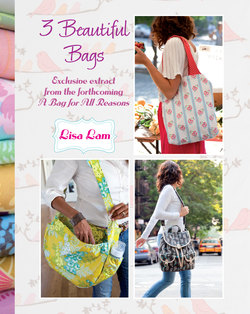Читать книгу 3 Beautiful Bags - Lisa Lam - Страница 11
Оглавление✧
Fold lines – when a pattern piece says ‘place on fold’ you
need to fold your fabric wrong sides together and place
the appropriate edge of the pattern piece onto the fabric
fold. In this way, the resulting cut fabric piece will be
double the size; a mirror image joined at the fabric fold.
✧
Notches – these are the small vertical lines that appear on
the pattern piece outline. These useful markings help you
to match up seams and fabric edges accurately. Pattern
pieces that need joining up will have corresponding
notches. Transfer pattern notches to your fabric pieces
using a disappearing marker or make small nicks with
sharp scissors.
✧
Other markings – magnetic snap/bag handle hook/zip
pocket etc. markings need to be traced onto your patterns,
and then transferred to your fabric pieces.
Glossary of terms and abbreviations
In addition to the patterns, you will also need to be able to
follow the written instructions for each technique or project.
The following terms are used throughout this book and in other
commercial patterns.
✧
✧
✧
✧
✧
✧
✧
✧
✧
✧
✧
✧
✧
✧
✧
Bag lining/bag exterior – most bags have a lining and
an exterior, which essentially means that most bags
consist of two bags (the inside bag and the outside
bag). Each bag is made separately before being joined
together towards the end of construction. In this book
I refer to the inside bag as the ‘lining bag’ and the
outside bag as the ‘exterior bag’.
Clip – clipping your seam allowance helps seams lie flat
when you turn your project right side out by reducing
bulk in the seams (especially curved seams). For
inward curves cut small V-shapes pointing towards the
stitching along the seam allowance close, but not too
close, to the stitching. For outward curves make small
scissor nicks pointing towards the stitching (again, not
too close to the stitching).
Clip corners – snipping off the seam allowance reduces
bulk in the seams of straight corners and makes for
smoother and sharper corners on your bag when it is
turned right side out. This results in neater rectangular
pockets or fabric straps, for example. Before turning
right side out, trim off the corner tips of your work
close, but not too close, to the stitching.
Raw edges – refers to the cut, unstitched and
unfinished edges of fabric.
Sewing in a box formation – particularly useful for
stitching strap ends down securely onto your work.
Stitch the item in a box shape for extra strength
and durability.
Topstitching – a line of stitches that runs close and
parallel to an edge on the right side of your work. The
distance between the stitches and the edge will vary
according to your preference or the instructions in
the project. Topstitching is very useful in that it often
serves both decorative and reinforcing functions.
Turning right side out (sometimes abbreviated
– TRSO) – simply means that you need to turn your
(inside out) work the right way out. Turning wrong
side out means the reverse of the above.
WS – wrong side – the reverse or back of your work
or fabric.
WST – wrong sides together – bring two pieces of
fabric together so that the wrong sides of the fabrics
are touching each other.
WSO – wrong side out – the wrong side of your work/
fabric is facing outwards.
WSU – wrong side up – the wrong side of your work/
fabric is facing upwards.
RS – right side – the good or the front side of your fabric
or work.
RST – as WST, but with the right side.
RSO – as WSO, but with the right side.
RSU – as WSU, but with the right side.
Getting Started
